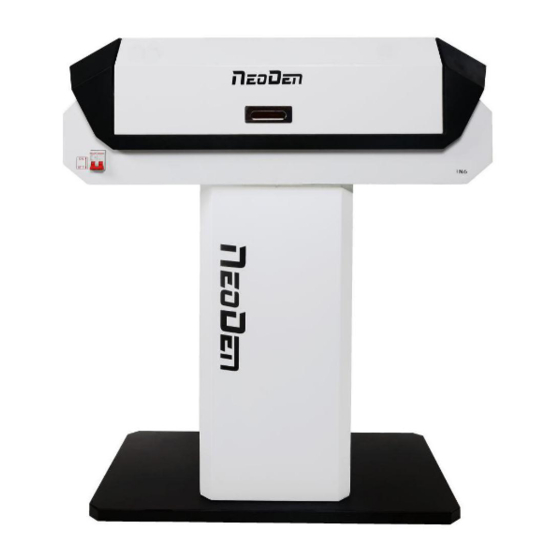Summary of Contents for NeoDen IN6
- Page 1 Hangzhou NeoDen Technology Co., Ltd User Manual Reflow Oven NeoDen IN6 -Full hot-air convection -Built-in welding smoke filtering system...
-
Page 2: Table Of Contents
Content 1. Brief Introduction........................1 2. Specification..........................1 3. Main Parts..........................2 3.1 Reflow Oven Main Body....................2 3.2 Operating Panel......................2 3.3 Pedestal..........................2 4. Installation Instruction......................3 4.1 Power Supply Connection.....................3 4.2 Installation Attentions....................3 4.3 Status of Indicators......................3 4.4 Operation instructions....................3 5. -
Page 3: Brief Introduction
Please read the user manual carefully before operating this machine. 1. Brief Introduction IN6 is a newly designed, environmentally friendly reflow oven with stable performance. It can achieve full hot-air convection, excellent soldering performance. It has 6 temperature zone, light and compact. -
Page 4: Main Parts
3. Main Parts 3.1 Reflow Oven Main Body 3.2 Operating Panel 3.3 Pedestal... -
Page 5: Installation Instruction
4. Installation Instruction 4.1 Power Supply Connection IN6 is used in 110V/220V single-phase connection mode and is connected according to the user environment. Wires connection method is shown as picture. L stands for the live wire, N stands for the zero wire, and E stands for the ground wire, connect to the 220V (110V) power supply. - Page 6 Power switch Turn the red power switch to the ON position and the machine starts. ♦Transfer chain speed setting Tap the speed parameter on the screen and press the Up/Down button to set the appropriate transfer chain rotation speed. When the speed is set, the time required to transport a PCB at this setting speed is displayed on the right side of the screen.
- Page 7 ♦Change language and the unit of temperature in machine After the power switch is turned to ON, the NeoDen logo will be displayed on the screen. Long press the OK button to enter the Debug mode interface. In this interface, you can change the...
-
Page 8: Temperature Wave Setting Principle
5. Temperature wave setting principle 5.1 The reflow soldering theory and the temperature wave When the PCB goes into heat up area (dry area), the solvent and gas in the solder paste will evaporate. At the same time, the flux can wet the pad and the component tip and foot. The solder paste melts, caves in and covers the pad, leading to the pad and component pins insulate the oxygen. -
Page 9: Temperature Measurement Method
should increase the transfer chain rotation speed or reduce the set temperature. ♦Different PCBs boards have different heat transmission rate and heat absorption capacity, so it requires the reflow oven offers different heated time and quantity of heating. To double-side PCB, multi-board and other PCBs with many bonding pads, they have a higher temperature setting. -
Page 10: Precautions
paste Flux coking Over heating Add transfer chain speed, lower temperature PNP wrongly, the tin on the solder pad is Check place position Components irregular or asymmetrical, drying too fast Check the shape and thickness of tin wrong position causes airflow to blow components Lower transfer chain speed and temperature Tin bridging Misposition...










Need help?
Do you have a question about the IN6 and is the answer not in the manual?
Questions and answers